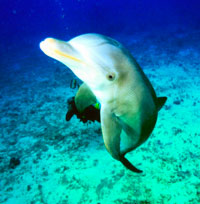Among the dolphin group, this the commonest and most studied species. It may reach 4 m and 500 kg and lives up to 60 years. It has an echo system to locate food and may work in groups to hunt. Bottlenose dolphin plays often with boats and swimmers. It is observed in Jardines de la Reina year around. Bottlenose dolphin is included in the Appendix II of Resolution 161/11.
Spotted dolphin (Stenella frontalis):

As its name indicates, spots cover the entire body of this dolphin but its dorsal fin. It may reach 2.3 m and 140 kg. Spotted dolphin is very active at the surface, swimming just below it and jumping above while traveling. It is common in Jardines de la Reina. It is included in the Appendix I of Resolution 161/11.
Sperm whale (Physeter macrocephalus):

As its name indicates, spots cover the entire body of this dolphin but its dorsal fin. It may reach 2.3 m and 140 kg. Spotted dolphin is very active at the surface, swimming just below it and jumping above while traveling. It is common in Jardines de la Reina. It is included in the Appendix I of Resolution 161/11.
Humpback whale (Megaptera novaeangliae):

It may reach 17 m, 40 tons and live 80 years. Its 5 m long pectoral fins is the distinctive feature of Humpback whales. In winter, it migrates to tropical and subtropical waters to reproduce. Humpback whales are friendly and curious animals not afraid of boats and people and well known by their jump and songs. To feed on krill and small fish, Humpback whales produce “bubble net” to concentrate prey on surface. It is is spotted often in Jardines de la Reina. Humpback whale is included in the Appendix I of Resolution 161/11.



